Start Free For 7 Days
10 things to know as a traveling dancer.

You see them all over YouTube: Videos of your favorite choreographers teaching in Germany, Japan, Russia, etc., and you think to yourself, “ Man, it would be awesome to be paid to teach and dance in another country! ” So you train, take classes , join cyphers , try out for teams ... and if you play your cards right, you could end up being able to live this dream.
If you’re looking for some tips, I’ve written an article on how to accomplish such a task . But once you do accomplish this feat, what next? What is it like traveling to another country where you most likely have no idea how to speak the language, what sort of customs to expect, or what to do when you get there?
After traveling to a couple of different countries doing different gigs for dance, whether it be touring or teaching, I’ve run into some common themes that I think the aspiring traveling dancer should know prior to their trip into the unknown.

1. Don’t wait until the last minute to get your travel papers:
The first thing you should do is make sure your passport is in good order and current. If you need to get a Visa for the country you are going to, it's important to do it ASAP. It has always taken me roughly two weeks to a month to get this done, and I’ve had to pay a pretty penny to get it expedited when I procrastinated.
2. Do some research before adventuring out:
This might come as a no brainer, but do your homework before traveling to another country. Find out what the weather is currently like, or if you will need to watch out for certain bugs (some things people don’t consider are the little things). Is the water safe for drinking, or is it better to spend the money on bottled water to avoid getting sick? Consider the time differences and location. Some countries/cities could have weather changes like night and day. The more you know going in, the less stress you will have by being prepared, and less stress = more fun.
3. Know your place:
I’ll say it: Being born in America, we have a tendency to feel ‘entitled’; it seems to be a common thing I’ve noticed traveling with other Americans or meeting others from America. Just remember, you are a foreigner to their country. Anything that could lead to trouble could lead you to be deported - know the consequences. It’s a great idea to keep your head on straight when you encounter troubling situations. Better yet, avoid these situations completely .
4. Make friends with the locals and performers:
Of all the amazing things I’ve experienced traveling, the top of the list are the people I’ve met. Being a dancer means meeting other dancers on your travels , and the best part is dancing is universally understood in any language. Building those bonds with people across the world is a surreal experience, something that merely adding people on social media can never really accomplish. Life is about making experiences and the people you share it with, so use every opportunity to create some lasting ones.
5. Be extremely careful:
This may seem like a no-brainer, but it's still very important to note - we’ve all seen the movie Taken. Take it from someone who has actually been kidnapped on one of their trips to a different country, that stuff actually happens. It goes hand in hand with doing research on the place you are traveling to, but be sure to know what is safe or not. Common things to be aware of are not to go anywhere at night alone if you can avoid it, only take clearly marked taxis and public transportation, and know where the U.S. Consulate and police stations are located in case of emergencies.
6. Pack accordingly:
What type of trip are you going on? Are you going to be staying in one location for the most part, or are you going to be on tour? It might seem like a good idea to bring everything you own just in case, but touring becomes really difficult having to lug around three different bags plus two carry ons everywhere. Try to get good at packing one good sized carry on. It might sound crazy, but trust me, you’ll be thanking me for it later. Know what type of adapters for your electronics to bring, universal adapters aren’t usually very expensive. Bring medicine, first aid equipment, any travel sized sanitation and bug spray.
7. " Hold on, let me take a Selfie ":
I’m absolutely terrible at documenting experiences. I’ve always been more of a live-in-the-now type of guy instead of snapping away memories to keep. Ditching this mentality on my last trip around the world was a welcome change. Living in a digital age where even your toothbrush seems to have a camera, it makes it easy to take all the pictures of everything. These are things you’re going to enjoy long after your trip is done. And let’s face it, how else are you going to brag to share with everyone else about what you’re doing?
8. Stay connected:
Sometimes it’s hard to stay connected with friends and family when you’re traveling. It can be worrisome to them when you can’t be reached. Get an international sim card for your phone if you can, and download apps to stay in contact (WeChat is one of the best texting apps for traveling, and it has the added perk of being free!). Skype is always a go to application to stay in touch. Most places have some sort of access to WiFi, so utlizing these locations is nearly a must. One of the most helpful phrases I’ve come to find out is, “what is the password to the wifi?” It’ll make your life so much easier; it's practically right up there with “where is the bathroom?”.
9. Know how to get around:
The first time I was in Japan, I had to take the train to get to my destination after getting out of the airport. Anyone that has tried to read the train schedule and routes for the first time knows where I’m going with this. Reading the train routes is like trying to decipher hieroglyphics. Some stations make finding the route to your destination easy, but don’t rely on these to be everywhere. Know in advance how to tell someone your destination if you need to take a taxi or bus. It can save a ton of headache by saving the address on your phone, because sadly, Siri isn’t much help here.
10. Be responsible with your finances:
A lot of things can happen while you’re away from home. Having access to an account at home might be out of the question, so knowing how much your trip might cost you is essential. I recommend plotting out how much each day is roughly going to cost and go from there, adding a bit more for recreational activities..... SIKE - we’re all broke dancers!
But in all seriousness, the best case scenario is to be smart with the money you have, or the money you receive. Know when to spend your money, and when to save it.
Have you had to travel somewhere else to dance or teach? What advice would you give to those who are about to do so? Leave a comment below to share your opinions! We can't stress the importance of #4 enough - but to help us with this task, check out this article about networking - or neTWERKing as dancers !
Like our stories?
Subscribe to our newsletter.

Learn to dance at your own pace.
Try it free for 7 days., join the only studio that moves with you.

- Collaborators
- Hypermobility
- Ankle Focus
- Body Awareness
- Coordination
- Conference 2021
- Recommendations
Travel refers to the ability to move the centre of gravity along the horizontal plane with efficiency and control.
The purpose of this activity is to develop the dancer’s ability to: * travel efficiently and safely * extend their movement vocabulary * execute movement at different speeds * have clear, sustained focus * travel in clear directions and pathways * spatial awareness * develop group listening – the ability to work with others in the space
As with all dance skills, a combination of elements determine the dancer’s ability to travel. Alignment, strength and use of effort all play a role in a dancer’s capacity to travel efficiently and safely. More information on building strength and good alignment in the lower leg can be found here .
Preparation is important to ensure activities that involve travelling are safe. When planning a lesson it can be useful to start with the later activities and work backwards to ensure the dancers have been suitably prepared for them. More information on preparatory activities can be found here .
Travelling activities provide a good opportunity to introduce and develop set movements (e.g. galloping, turning) and other elements such as, directions, clear pathways and eye focus. Finding and maintaining a clear eye focus can be challenging for some dancers, but setting it can help dancers remember a sequence.
Group listening, awareness of others in the space and how to react to them, is an important skill to develop. Giving the dancers time to rehearse together in the space while working independently can help to develop this.
Cool down activities can be found here .
The European Commission support for the production of this publication does not constitute an endorsement of the contents which reflects the views only of the authors, and the Commission cannot be held responsible for any use which may be made of the information contained therein.
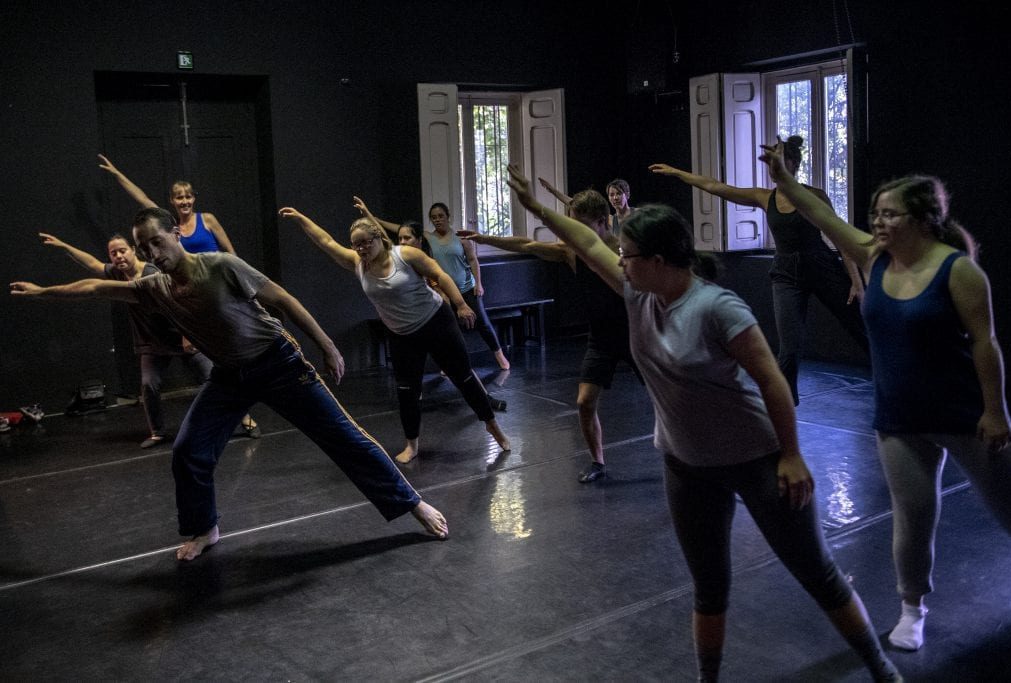
Teaching Guidelines
This activity uses a wide range of teaching methods to appeal to different learning styles. Visual and tactile methods of communication are generally more accessible and effective for dancers with additional learning support needs. This activity works best towards the end of class.
The approach taken in this activity is to begin by providing an outline of the whole sequence (the floor pattern). The detail is then gradually filled in by the teacher and dancer themselves. This strategy can be useful for many dancers but particularly those with hypermobility who can be overwhelmed when receiving a lot of information at once. This can result in the defence mechanism of fight, flight or disassociation. More information on psychosocial markers, anxiety and bodily crisis in Joint hypermobility can be found here . Additional elements, such as introducing different speeds, levels or starting points can be added as the dancer becomes ready. More information on building a sequence can be found here .
Remembering a sequence accurately can be challenging for dancers, especially if they have created it themselves. Teaching their sequence to a partner can help improve movement memory as it requires the dancer to clarify the movement and repeat it numerous times. Being in a teaching role also encourages autonomy, develops social and communication skills and the ability to switch between leader and follower roles.
Developments for this activity could include: * starting at different points in the sequence * changing speed and levels * in duets and trios – playing with distance and eye focus to suggest relationship * developing and performing in larger groups * introducing an object
In this activity we used the following methods of delivery. However, you may find others on the list more suitable for your dancers:
* verbal instructions * use of voice; intonation, pace * use of music/sounds * imagery delivered verbally
* physical demonstrations * visual imagery (picture, object)
* tactile cues given by self, peer, or teacher * physical objects
Kinaesthetic
* experience how the movement feels e.g. resistance, pressure, effortless etc.
* verbal feedback from peer or teacher * visual feedback from peer or teacher * tactile feedback from peer or teacher * visual feedback and self-correction

SHIFT Dance
All Rights Reserved. All photographs by Brian Slater, Daniel Gago, Gavin Joynt, Jacobo Medrano, Joop Oonk and Rob Hogeslag Creative Commons License This work is licensed under a Creative Commons Attribution-NonCommercial-ShareAlike 4.0 International License
© 2024 SHIFT Dance. The European Commission support for the production of this publication does not constitute an endorsement of the contents which reflects the views only of the authors, and the Commission cannot be held responsible for any use which may be made of the information contained therein.
- Glossary Of Terms
- Privacy Policy
Privacy Overview


Dance Around the World | 16 Styles of Dance From Across the Globe
One of the most fun ways to experience a new culture is through music and dance – whether as a spectator, by taking a class or attending a cultural event. You don’t have to share a language to make a connection through the music, so take this bucket list and dance around the world–virtually or literally.
1. Tango – Argentina
I had a deal with my husband: I will cycle the “Road of Death” in Bolivia, and you will take a tango class with me in Argentina. Of course, that didn’t happen. Yes, I cycled the Road of Death because I am a woman of my word, but I’m still waiting for that tango class. Tango is fabled to have developed in the streets of La Boca, a suburb of the Argentine capital Buenos Aires.
Though its origin was probably far more geographically spread than this, there is no doubt that tango was the product of low socioeconomic areas where immigrants and slaves gathered. The cross-pollination of cultures and their creativity gave rise to unique art, music and dance, such as the tango.
2. Flamenco – Spain
It’s no accident that I named this blog Duende which is a Spanish word intrinsically linked to flamenco, a form of dance I have been fascinated with since childhood. Flamenco music and dance is believed to have emerged from the culture of Andalusian Roma (Gypsies) that migrated over centuries from Northern India to southern Spain, combined with the Moorish and Jewish influence of Andalusian residents.
Both the melody and choreography of flamenco are traditionally improvised within a traditional structure. Men’s flamenco moves feature elaborate toe and heel tapping, while women’s choreography generally constitutes more graceful hand and body movements. The dance form also incorporates finger clicking, clapping and shouting to express the often melancholy themes of the music.
3. Salsa – Cuba
Since the tango lesson never happened, I was all over that s**t when it came our trip to Cuba several years later. There was no escape for my husband and quite incredibly he survived the experience – fancy that! Salsa music and dance were born in eastern Cuba of mostly Spanish and African ancestry. The style migrated west to Havana and leapt across to New York in the 1950s, where jazz was added to the list of its musical influences. Regional variations of the music and dance developed as they spread across the globe, but salsa’s roots are firmly planted in the Caribbean.
4. Viennese Waltz – Austria
The Viennese Waltz was scandalous on its 18th-century debut—up to that point, men and women did not dance in hold, nor expose their ankles. It survived the initial disapproval to become all the rage in high society and subject of compositions by the likes of Josef Lanner and Johann Strauss. The Viennese Waltz is commonly danced to music 180 beats per minute, double that of the English Waltz (aka Slow Waltz or THE Waltz) you probably learnt in school. Originating from Austrian and German dances the Viennese Waltz is considered the oldest ballroom dance. I’m coveting an opportunity to don a ball gown and dance up an elegant storm in Vienna during ball season, that runs each year from November to January.
5. Hip Hop – U.S.
Hip hop dance evolved hot on the heels of hip hop music in 1970s New York City. The original style was “breaking” to up-tempo breaks in rock or funk songs. As the music slowed, breaking receded and gave way to “hip hop freestyle”, that was more social dance with a few recognizable steps such as the “running man”. Meanwhile on the West Coast, “popping and locking” were being popularised and followed later by hyper-aggressive Krumping. All of these styles are classified under the broader category of hip hop. I’m all booked in for my Birthplace of Hip Hop Tour of Harlem and The Bronx next time I’m in NYC. I’ll let you know how it goes!
6. Raqs sharqi – Egypt
Our next stop, as we dance around the world, is Egypt. Belly dancing is a western term for traditional Middle Eastern dance forms such as raqs sharqi (classical belly dance) and raqs baladi (folk or social belly dance). The Dom people, thought to be cousins of the Roma, left Northern India around the 6 th century. They travelled west through the Middle East to Northern Africa. Among them were a group of female dancers known as ghawazi (or ghawazee) who are responsible for developing the foundations of raqs sharqi. Later western influences such as ballet, ballroom and Latin dance evolved the style further to what has been globally popularized as belly dance.
7. Adumu – Kenya & Tanzania
Adumu aka “that jumping dance” is performed by young males of the Maasai tribe that live in southern Kenya and northern Tanzania. They perform this dance during their coming of age ceremony known as Eonoto, which marks their transition into warriors. The men will stand around in a circle while one or two move into the centre and begin jumping without letting their heels touch the ground. The surrounding warriors will adjust the pitch of their chanting based on the height of the jumpers. A graceful, trampoline-high jump is the aim, to impress onlooking suitors.
8. Lion dance – China & Singapore
The lion dance is an ancient tradition in China. You’ve likely seen it before at Chinese New Year celebrations. The lion dance is not to be confused with the dragon dance. The lion is usually two dancers per costume, which is adorned with fur and has large blinking eyes. It’s also usually more mischievous and playful in personality than the scary dragon. Lion dances are performed to the sound of drums and cymbals, with the idea of scaring away bad fortune. That‘s why lion dances are often incorporated into Lunar New Year festivities or the opening of a new business – for good luck and prosperity. When I lived in Singapore, it was a unique sight to glimpse open trucks transporting costumed lion dancers from gig to gig around the city during Chinese New Year.
9. Step dancing – Ireland
It was recently brought to my attention during a trivia competition that I am old because I know who Michael Flatley is. So listen up youngins… back in the mid-1990s, there was a stage show featuring Irish step dancing that was called Riverdance. It brought the dance style international attention and adoration. Michael Flatley and Jean Butler were the Irish dancing champions who headlined the show in the beginning. Irish step dancing has a long and largely untraceable history.
Its evolution is said to have begun with the Celts who performed pagan dances in a circle formation and often involved tapping of the feet. The Normans arrived in the 12 th century and brought with them a dance known as Carol which inserted some influence. By the 18th-century roving “dance masters” travelled the Emerald Isle teaching a variety of styles including French cotillions and quadrilles to the masses. Finally, the Gaelic League formed in 1893 to promote Irish culture after long-held British rule. They formalized Irish dancing competitions with standardized rules and organized lessons, that have promoted step dancing to where it is today.
10. Hopak – Ukraine
You probably know the Ukrainian national dance hopak, as Cossak dancing, which was originally a victory dance celebrating military battles in the 17 th century. Men returning from battle to the Zaporizhian Sich, the fortified capital of the Cossaks, would perform improvised dances and stylized battle re-enactments called hopaky. Their soundtrack was provided by community musicians playing violins, bagpipes, fifes and cimbaloms (Hungarian string instruments). Their signature squats, kicks and acrobatics reinforced their heroism to the crowd. Historically there was no set tune and musicians took their cue from the dancers, performing at a tempo that reflected their movements. Hopak music evolved over time and a famous example is Tchaikovsky’s opera Mazepa. The dance progressed too, as the dance grew popular among the civilian population and female dancers joined the men.
11. Hasapiko – Greece
Syrtaki, also spelt sirtaki, is what most likely comes to mind when you think of Greek folk dances. That one where dancers stand in a line or in a circle with their hands on their neighbours shoulders, dancing to music that begins slowly and gradually increases in tempo. Well, that came about in the 1960s when a dance was created for the movie Zorba the Greek. Hardly what you were hoping for in an ancient culture right? Well, fortunately, the choreography of this dance was based on that of an older routine called hasapiko. Hasapiko can be traced to Constantinople (modern day Istanbul) as a dance butchers performed with swords in the Middle Ages.
12. Hula – Hawaii
Ancient Hawaiian civilization did not possess a written language. Their history, mythology and culture were recorded and relayed from generation to generation through song and dance. When Western missionaries arrived, they were quick to frown upon Hula and at one time public performances were banned. The storybook of dance was set free again by King David Kalakaua in 1874. Hula has two forms: hula kahiko, an ancient style performed to chants and percussion, and hula auana, a modern form danced to contemporary music.
13. Samba – Brasil
Samba grew from African slave dances (primarily Congolese and Angolan) on Brazilian sugar plantations. The word “samba” is derived from the Angolan word “semba” meaning “invitation to dance.” When slaves were freed and moved into favelas (shantytowns), they formed dance groups that would perform during Carnival celebrations, the most famous of which is in Rio de Janeiro. The samba has several forms, some dance solo and others with a partner. Solo samba steps include weight shifting, sliding the feet, ball changes and fast footwork, along with arms that respond to leg and hip movements. See images from my Rio Carnival experience here.
14. Dabke – Syria, Iraq, Jordan, Lebanon, Palestine
Dabke originated as a kind of “hei ho, hei ho, its off to work we go” work associated activity of the Levantine region covering Syria, Iraq, Jordan, Palestine and Lebanon. When the weather changed, the rooves of houses traditionally constructed from tree branches and mud, would crack. The homeowner would summon their family and neighbours to assist with repair which generally involved holding hands in a line and stomping on the roof, often accompanied by improvised singing.
For this reason, dabke has a deep association with family and community, and today is mostly performed at special occasions such as family gatherings and weddings. Dabke has evolved over history and has many regional versions. The line of dancers is led by the “Lawweeh” who is usually a male and often waves around a handkerchief. I chose to highlight dabke, not only because it is part of my cultural heritage (I have Lebanese ancestry), but because it covers a broad geographical area that crosses modern borders.
15. Robam Tep Apsara – Cambodia
Apsara or Robam Tep Apsara, is a Khmer classical dance. The Khmer people are an ethnic group of Southeast Asia native to Cambodia where you are most likely to experience this form of dance, along with neighbouring nations of Thailand and Laos. The Apsara, in Hindu mythology, are female spirits representing water and clouds, that visit the earth to deliver messages from the gods to kings and entertain them with their dance. They also have the power to entrap men who threaten peace by hypnotizing them with beauty and their gracefully slow moves.
In 2003, UNESCO recognised Apsara dance “the Royal Ballet of Cambodia” as a masterpiece of oral and intangible heritage. Keep an eye out as you explore the various temples of the Angkor complex, their walls are adorned with carvings of Apsara dancers which have inspired the costumes and movements of modern Cambodian choreographers trying to recapture their history. Instead of a pure Apsara dance performance video, I’ve included a TED Talk by Prumsodun Ok which gives insight into the storytelling and cultural context of Apsara in modern-day Cambodia.
16. Haka – New Zealand
The haka is a dance that leaves nothing on the table, emotionally or physically. It is traditionally an ancient Māori war dance used on the battlefield to intimidate opponents and in unifying moments of peace. Dancers (or warriors) keep time by rhythmically stamping their feet, while loudly chanting, gesturing with their hands and making fierce facial expressions. If you’ve ever watched New Zealand’s rugby team, the All Blacks, then you’ve probably seen them perform the haka pre-match. It’s my favourite part of the game! Today, the haka is used in important ceremonies and celebrations such as weddings, birthdays and other life-affirming events. It is performed as a welcome and to honour special guests.
Travel inspiration for dancers and dance lovers stuck at home
If you can’t travel to these destinations, there are plenty of videos on Youtube that will instruct you on the basic steps of each dance. Clear the lounge room and have some fun! You might also enjoy the PBS show Bare Fee t , hosted by Mickela Mallozzi who travels the world experiencing music and dance.
Tell us what dance styles you’d most like to experience in the comments below.
Peace, love & inspiring travel,
Ideas for Decorating with Travel Souvenirs
How to have a postcard-perfect maldives vacation, leave a comment cancel reply.
Save my name, email, and website in this browser for the next time I comment.
Don't subscribe All new comments Replies to my comments Notify me of followup comments via e-mail. You can also subscribe without commenting.
This site uses Akismet to reduce spam. Learn how your comment data is processed .
This website uses cookies to improve your experience. We'll assume you're ok with this, but you can opt-out if you wish. Accept Read More

- school Campus Bookshelves
- menu_book Bookshelves
- perm_media Learning Objects
- login Login
- how_to_reg Request Instructor Account
- hub Instructor Commons
- Download Page (PDF)
- Download Full Book (PDF)
- Periodic Table
- Physics Constants
- Scientific Calculator
- Reference & Cite
- Tools expand_more
- Readability
selected template will load here
This action is not available.

1.18: Elements of Dance
- Last updated
- Save as PDF
- Page ID 199416

Learning Objectives
- Recall the Elements of Dance
- Distinguish between the Elements of Dance
- Analyze, identify, and describe the Elements of Dance
“A dance, as a work of art, must be constructed as well as a beautiful building…. A dance must have a beginning, development, and climax – just as a building has foundations, walls, and roof.” -Ted Shawn
What are the Elements of Dance?
The Elements of Dance are the basic building blocks of dance that help us identify and describe movement, assisting in the ability to analyze, interpret and speak/write about dance as an artistic practice. When viewing dance, we want to put into words what we are witnessing by analyzing its most important qualities. The elements of the dance provide us with the tools to do so.
In dance, the body can be in constant motion and even arrive at points of stillness. However, even in stillness, the dancers are inherently aware of themselves. No matter the case, all forms of dance can be broken down into their primary elements: BODY, ENERGY, SPACE, and TIME. To easily remember the dance elements, we use the acronym: B. E. S. T., which stands for BODY, ENERGY, SPACE, and TIME. Dance can be seen as the use of the BODY with different kinds of ENERGY moving through SPACE and unfolding in TIME.
Let’s take a quick look at the elements of dance before we dig in further.
Randy Barron, Teaching Artist on the Kennedy Center’s National Roster, made this video to explain the Elements of Dance:
The body is the dancer’s instrument of expression. When an audience looks at dance, they see the dancer’s body and what is moving. The dance could be made up of a variety of actions and still poses. It could use the whole body or emphasize one part of the body. Exploring body shapes and movement actions increases our awareness of movement possibilities.

Body Shapes
The choreographer who is designing a dance may look at their dancers as sculpture. They choose shapes for the dancers to make with their bodies. These can be curved, straight, angular, twisted, wide, narrow, symmetrical, or asymmetrical. These shapes can be geometric designs, such as circles or diagonals. They could make literal shapes such as tree branches or bird wings. They can also make conceptual shapes (abstract) such as friendship, courage, or sadness. Sometimes a choreographer emphasizes the negative space or the empty area around the dancers’ bodies instead of just the positive space the dancer occupies. Look at the positive and negative spaces in Fig 2.
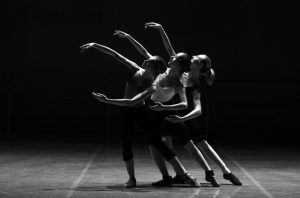
Body Moves/Actions
Dance movements or actions fall into two main categories:
Locomotor: (traveling moves) walk, run, jump, hop, skip, leap, gallop, crawl, roll, etc.
Nonlocomotor: (moves that stay in place) melt, stretch, bend, twist, swing, turn, shake, stomp, etc.
Below is an example of body movements and shapes by Modern Dance choreographer Paul Taylor.
Excerpt from Modern Dance choreographer Paul Taylor’s Esplanade. Observe how the dancers use locomotor movement as they run and form circular formations, and create lines in space.
Each part of the body (head, shoulders, elbows, hips, knees, feet, eyes, etc.) can move alone (isolated) or in combination. In the classical Indian dance form Bharatanatyam, dancers stomp their feet in a percussive rhythm. At the same time, the dancer performs hand gestures, known as mudras, codified hand gestures that are important in the storytelling aspect of Bharatnatyam to communicate words, concepts, or feelings.
Observe in the video below, how the dancer alternately emphasizes her feet and legs with her hand and arm gestures. In Classical Indian dance forms, facial expressions and hand gestures play an important role in storytelling.
Excerpt from Pushpanjali, choreographer Savitha Sastry performs a Classical Indian dance solo called Bharatanatyam. Observe how the dancer alternately emphasizes their feet and legs with hand and arm gestures.
In the next video, dancers are participating in the GAGA technique developed by Isralei choreographer Ohad Naharin. In this movement language, dancers are directed to listen to their inner sensations to elicit physical responses; movement. Notice how the dancers are integrating the entire body to create fluid and successive movement.
Check Your Understanding
Query \(\PageIndex{1}\)
An exploration of “how” a movement is done rather than “what” it is, gives us a richer sense of dance as an expressive art. A dancer can walk, reach for an imaginary object and turn, making these movements look completely different by changing the use of Energy. For example, anger could be shown with a loud quick walk, a sharp reach, and a strong twisting turn. Happiness could be depicted by using a delicate gliding walk, a gentle reach out, and a smooth light turn. Energy is what brings the dancer’s intent or emotion to the audience. The element of Energy is sometimes called efforts or Movement Qualities.
Dancer and movement analyst Rudolf Laban broke it down into four efforts, each of which is a pair of opposites:
- space (direct or indirect use of space) When the dancer is paying attention to the use of space, they can be direct, single-focused, and targeted in their use of space. Conversely, they can be indirect, multi-focused, and aware of many things in the space around them.
- Weight or force (strong or light use of weight) The dancer can emphasize the effort or use of force by fighting against it, throwing their weight and strength into movements. The opposite is using a yielding, light sense of weightlessness in their movements.
- Time (sudden or sustained use of time) Not to be confused with tempo, the dancer’s use of time can be reflected in their movement. It can appear hurried, as though fighting against time. Conversely, the dancer can have a relaxed attitude toward time as though they have all the time in the world.
- Flow (bound or free use of the flow of movement) When the dancer’s flow is bound up, they can appear to be careful and cautious, only allowing small amounts of flow. The opposite is when the dancer appears to throw the movement around without inhibition, letting the movement feel carefree.
Another way we can define Energy is by looking at the Movement Qualities. Movement Qualities are energy released during various time spans to portray distinct qualities. There are six dynamic Movement Qualities.
- Sustained (slow, smooth, continuous)
- Percussive (sharp, choppy, jagged)
- Swinging (swaying, to and fro, pendulum-like)
- Suspended (a moment of stillness, the high point, a balance)
- Collapsed (fall, release, relax)
- Vibratory (shake, wiggle, tremble)
Notice the kinds of Energy the dancers are displaying in the examples below.
In the first video the dancers are using efforts of direct, strong, sudden and bound movements. In terms of Movement Qualities the dancers are using percussive, vibratory, and moments of collapse.
Hip Hop dance crew Kaba Modern uses the efforts of direct, strong, sudden, and bound movements. In terms of Movement Qualities, the dancers use percussive, vibratory, and moments of collapse.
In the National Opera of Ukraine’s preclude from Chopiniana, the dancers are using efforts of light and free. The Movement Qualities are sustained and suspended.
Query \(\PageIndex{2}\)
Let’s look at where the dance takes place. Is the dance expansive, using lots of space, or is it more intimate, using primarily personal space? An exploration of space increases our awareness of the visual design aspects of movement.
- Personal Space: The space around the dancer’s body can also be called near space. A dance primarily in personal space can give a feeling of introspection or intimacy.
- Negative Space/Positive Space: Sometimes, a choreographer emphasizes the negative space or the empty area around the dancers’ bodies instead of just the positive space the dancer occupies. Look at the positive and negative space in the photograph below.
- General Space: The defined space where the dancer can move can be a small room, a large stage, or even an outdoor setting.

- Directions: While dances made for the camera often have the performers facing forward as they dance, they can also change directions by turning, going to the back, right, left, up, or down.
- Pathways or Floor Patterns: Where the dancer goes through space is often an important design element. They can travel in a circle, figure eight, spiral, zig-zag, straight lines, and combinations of lines.
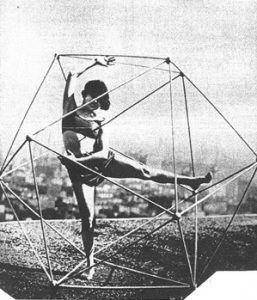
Excerpt from George Balanchine’s ballet Apollo. Notice the interlocking of circles of the dancers’ arms and the straight lines made by the dancers’ legs.
In this next video, notice various floor patterns such as circular pathways and straight lines that are made by the group of dancers. Observe the dancers’ use of gestures that go from near to far reach from personal space to filling the general space. The choreography also uses levels from low to high.
Query \(\PageIndex{3}\)
Dance is a Time art; movement develops and reveals itself in Time. Adding a rhythmic sense to movement helps transform ordinary movement into dance and informs when the dancer moves.
- Pulse: The basic pulse or underlying beat
- Speed (tempo): Fast, moderate, slow
- Rhythm Pattern: A grouping of long or short beats, accents or silences
- Natural Rhythm: Timing which comes from the rhythms of the breath, the heartbeat, or natural sources like the wind or the ocean.
- Syncopation: Accents the off-beat in a musical phrase.
Compare the different uses of Time in the two videos below.
In the first video, the dancers have no musical accompaniment and use their breath to initiate movement and cue each other for the timing. Their movement is also slow to moderate tempo and imitates the natural rhythm of the ocean.
Excerpt from Modern Dance choreographer Doris Humphrey’s Water Study. In this video, the dancers have no musical accompaniment and use their breath to initiate movement and cue each other for the timing. Their movement is also slow to moderate tempo and imitates the natural rhythm of the ocean.
Promo clip of Step Afrika!, the dancers are creating rhythm patterns with body percussion. There is an emphasis on syncopation and varying tempos with accents.
All dance forms share foundational concepts known as the Elements of Dance. The Elements of Dance are overarching concepts and terminology that are useful when observing, creating, analyzing, and discussing dance. Dance can be broken down into its primary elements : body, Energy, space, and Time. It can be easily recalled through the acronym B.E.S.T.
The body is the mobile instrument of the dancer and helps inform us what is moving. The body category includes shapes, actions, whole body, and part body movements. Energy is how the body moves. When speaking about Energy, we can refer to effort or movement qualities. space is where movement occurs and includes personal and general space, levels, directions, pathways, and floor patterns, various sizes of movements, range of movement, and relationships. Time is when the dancers move. The Time category includes pulse, speed, rhythmic patterns, natural rhythm, and syncopation.
As an observer of dance, it can be easy to allow our biases to influence how we perceive dance. By using dance vocabulary and stating what we observe, we can be more objective in our discussions of dance. Using the Elements of Dance, we can view dance through an unbiased lens to consider its structural elements to deepen our understanding and appreciation of dance as an art form.
1. Try making shapes that depict literal and abstract concepts. Some examples of literal shapes might be a flower, a seashell, or a rainbow. Some abstract shapes might be circles, diamonds, or even concepts such as friendship, heroism, or depression.
2. Make a short (10 second) dance phrase and perform it twice with two different types of energy.
3. On paper, draw a map with a continuous pathway without lines overlapping. After mapping your pathway, try adding locomotor movement on various levels that compliments your pathway design.
4. Make a sentence introducing yourself and your favorite food. For example: “Cissy Whipp likes chips and guacamole.” or “Vanessa Kanamoto likes grilled shrimp.” Now try clapping the rhythm your sentence makes. (Notice how the two examples have very different rhythms.) Create a movement pattern that matches the rhythm pattern of your sentence. Practice until you can repeat it four times in a row.
Query \(\PageIndex{4}\)
The Elements of Dance website from Perpich Center for Arts Education in
partnership with University of MN Dance Program https://www.elementsofdance.org/
- Dance Spirit
- Dance Teacher
- Pointe Magazine
- The Dance Edit
- Events Calendar
- College Guide
- Newsletters
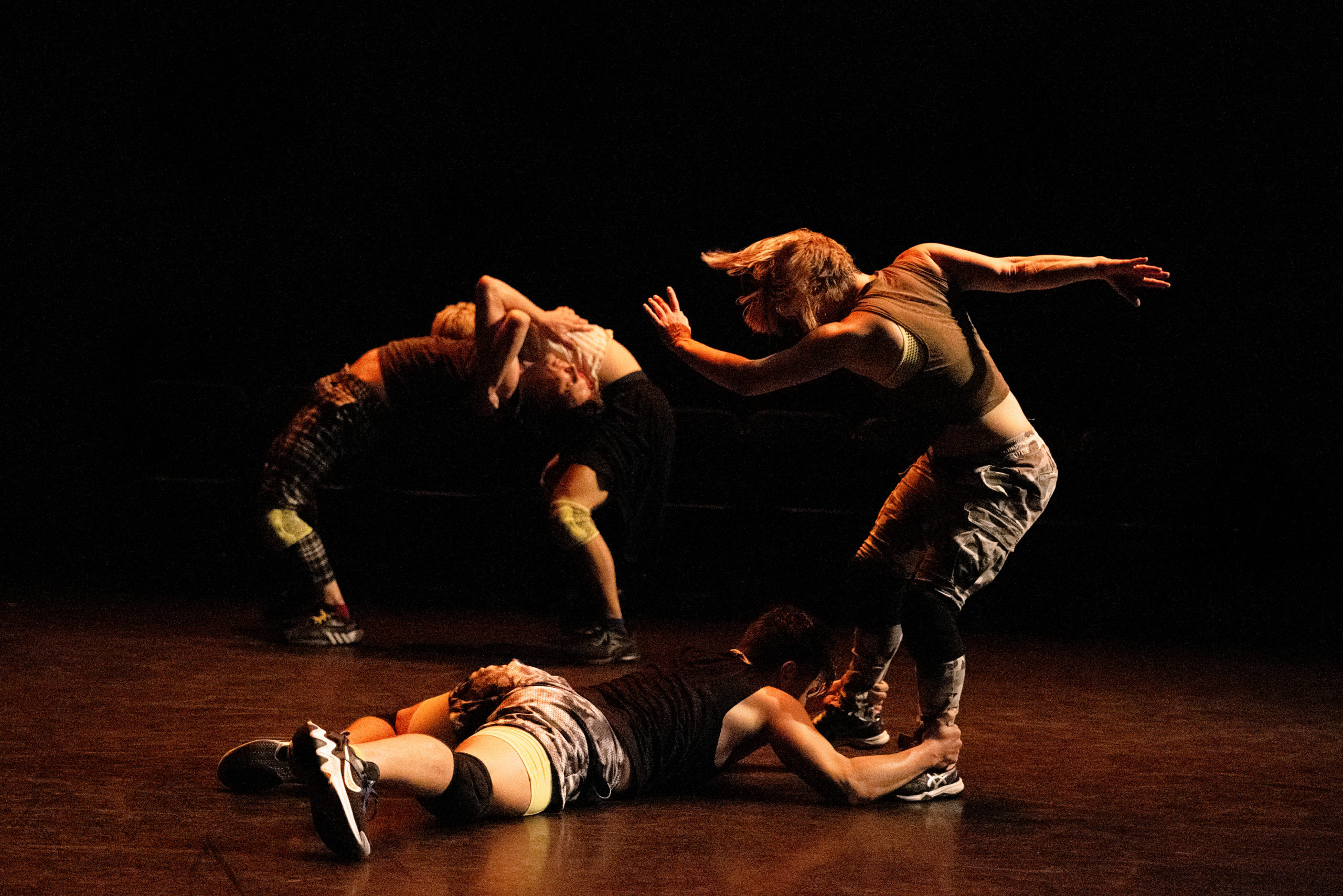
4 Tips for Traveling Further and More Powerfully Through Space
The dancers in Abby Zbikowski’s Abby Z and the New Utility company travel across the stage with such force, such explosive power, that it feels miraculous when they’re able to stop short before crashing into each other or an audience member.
Zbikowski’s thrilling, highly athletic style is unique. But the need for dancers to be able to explode across the stage—to “eat up the space,” as some teachers say—is not. Even in dance forms with a focus on elegance or lightness, being able to travel further, and thus take up more space, can result in more- exciting, more-dynamic performances.
But “eating up the space” can present psychological challenges—sometimes asking dancers to reject socialization that has encouraged them to take up less space—as well as physical ones.
Change Your Mindset
If you’ve often been told to dance bigger, or if you struggle to keep up with the group during traveling movement, it may be worth looking inward and interrogating the way you’ve been trained. The world at large teaches women and other marginalized identities to take up less space, says Zbikowski, and traditional studio culture often doesn’t address this in a way that would empower dancers to take up more. She says she often encounters students in her classes at The Ohio State University who have fear about moving with power and explosiveness, or have a psychological block. “You’re up against this pretty picture of what people think dance is,” she says. “And that sometimes locks people in their bodies.”
Internalizing the idea that, as Zbikowski says, “everybody has the right to take up as much space as they can in a dance studio” is not as simple as flipping a switch. Know that, like any new way of moving, this may feel unnatural at first, but that doesn’t mean it’s wrong, she says.
Use the Floor
In order to travel powerfully through space, dancers need to feel connected to the floor, so they can really push off of it, says Ivalyo Alexiev, a faculty member at Boston Ballet School. During his own dance career, Alexiev found that taking barre in socks helped him understand the relationship of his feet to the floor, and he recommends that dancers who typically dance in shoes experience the floor in this way during barre, if they are seeking more groundedness. Zbikowski agrees that using the floor is key to explosive movement, in any style: “The ground will help you get to where you need to be, whether it’s up or down or out or in,” she says. “It’s what connects us all.”
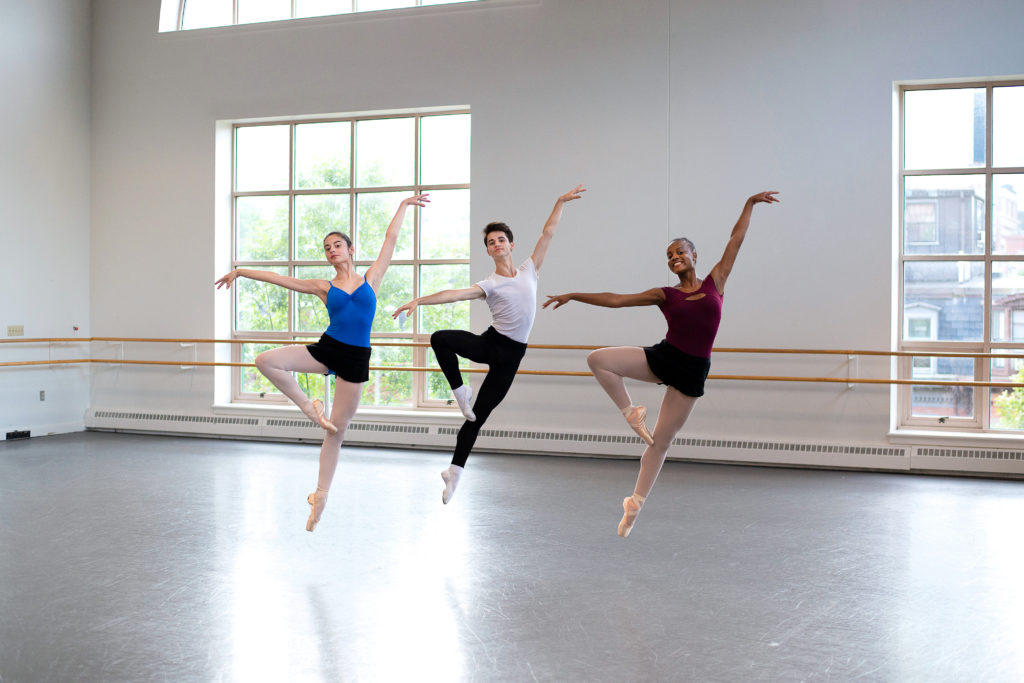
Channel Athleticism
For many dancers, one challenge lies in being able to tear through space while also maintaining the technique and artistry that the choreography demands. Zbikowski, whose approach is focused more on functionality and sensation than on making shapes, suggests that dancers tap into their power by (at least temporarily) allowing themselves to not care about what their movement looks like. To her, “dancer or athlete” is not a binary choice, and she encourages dancers not to put up a wall between dance technique and other types of movement. She helps her students channel athleticism through an “offense/defense” exercise, in which dancers partner up and “defend their space” without touching. “You’re not allowed to let your partner get by you,” she says. “So in order to make those quick breakaways, you need to drop your weight into the floor and leverage it in a specific direction. Putting people in these kinds of scenarios lets the body break out of certain strict regimens and discover things for itself.”
Short Dancers, Fret Not
Petite dancers, or dancers with short legs, may feel like they are at a disadvantage when it comes to traveling far and fast. But this isn’t necessarily the case, says athletic trainer Lauren McIntyre. Short dancers actually have potential advantages, she says, like having a lower center of gravity and the ability to turn over their stride faster.
Build Power
Here’s how to prime your body for explosive movement, according to athletic trainer Lauren McIntyre, who works with dancers at NYU Langone Health’s Harkness Center for Dance Injuries
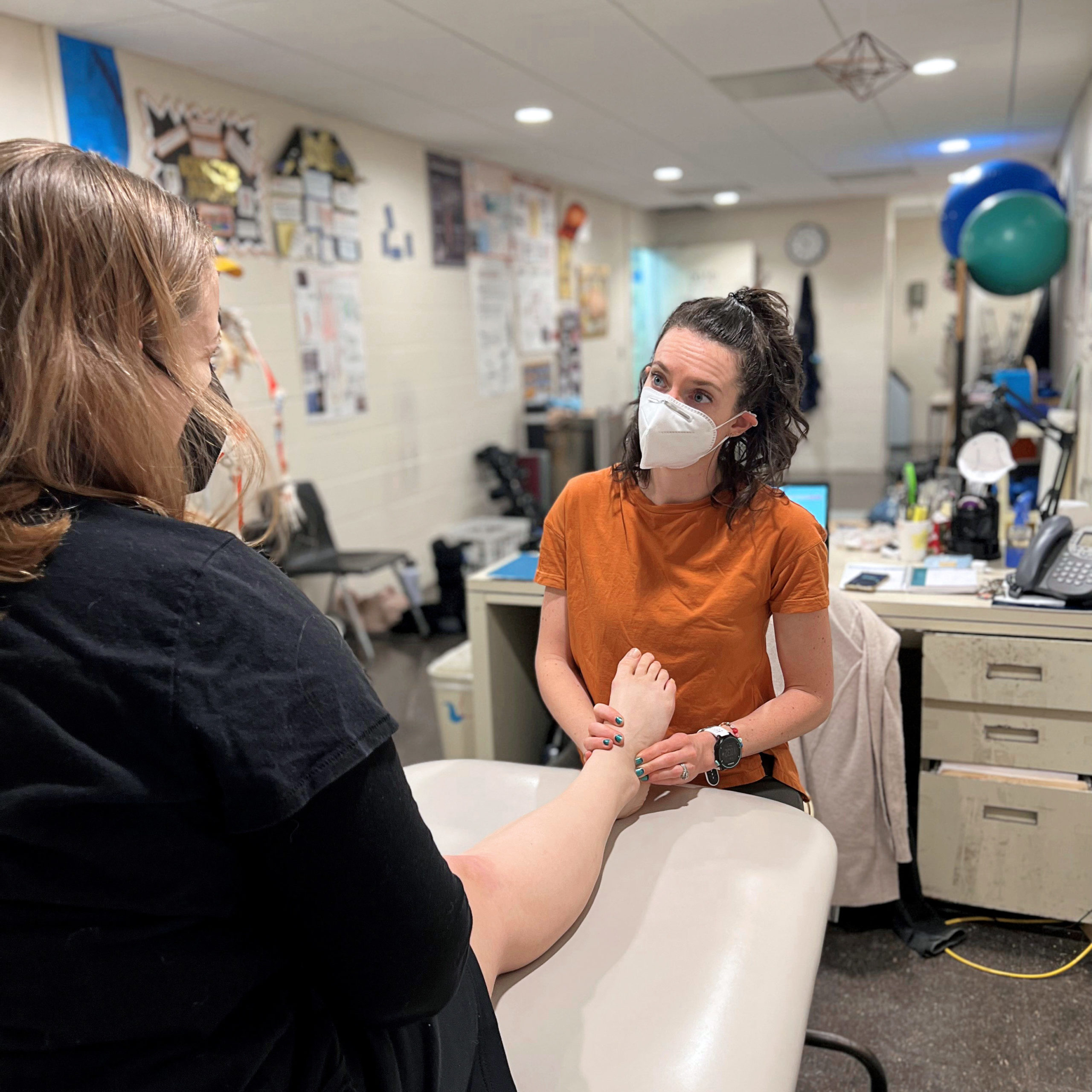
Fuel smart. In order to explode into space, your body needs to have carbohydrates available to energize that movement, says McIntyre, who cautions that low-carb diets likely won’t aid dancers in developing more power.
Train for power. Keep in mind that endurance training, strength training and power training are different, says McIntyre, and that most of the cross-training dancers are already doing is most likely more geared towards the former two. Plyometrics and HIIT can be useful for building power, she says, as can lifting heavy weights to build muscle. She also recommends using slightly lighter weights—about 30 percent of your maximum load—but performing faster reps, especially during the concentric part of the action (for example, the “up” part of a weighted squat). Before increasing load or speed, ensure you are confident in your form.
Rest up. Tired, overworked muscles will struggle to move explosively, says McIntyre, who cites a study showing that as fatigue increases, velocity decreases. This can be tricky for dancers with demanding schedules, especially if they are incorporating cross-training like plyometrics, which can be key for building power but demands proper recovery time in order to reap the benefits. She suggests that if dancers add cross-training to their routine, they look at their schedule as a whole and consider where they can build in rest—even if it means one less dance class per week.
Tailor your warm-up. When performing choreography featuring big, explosive movement—especially when that movement comes at the beginning of the piece—make sure your warm-up involves activating the fast-twitch muscle fibers you’ll need. In addition to dynamic stretching, foam rolling and getting your heart rate up, McIntyre recommends doing plyometric drills—like butt kicks, high knees or jumping jacks—to “rev your engine,” she says. “It’s about getting that metabolic pathway activated.”

TBT: Alfonso Ribeiro, Hinton Battle, and Alan Weeks Star in The Tap Dance Kid

UDA Nationals Went Viral on TikTok. What’s Next for College Dance Teams?

How to Integrate Acting Skills Into Dance

La Cage aux Folles ’ Cagelles, 40 Years Later: Something About Sharing, Something About Always
Subscribe to our newsletter.
Join our mailing list to receive the latest news and updates from our team.
Sign up for any or all of these newsletters Dance Magazine: Move and be moved Dance Spirit: Always on the beat Pointe: Ballet at its best Dance Business Weekly: Best moves for your business The Dance Edit: A petit daily newsletter
You have Successfully Subscribed!

How To Travel The World As A Dancer
If you were to ask a group of Millennials how to “travel and get paid to do it,” they’d all pull up their Instagrams and their blogs and show you analytics and affiliate links. And THEN, they’d probably try to sell you an e-course, a nomad guide or social media planner…To each their own, but personally this is when I start to go cross-eyed. Is this the new price of travel? I don’t dig the currency of scrolling, liking, pinning, and clicking my way to a plane ticket. Hypocritically, I must confess I have a travel blog myself. But when I travel I still try to experience life with my eyes wider…not buried in my smartphone or laptop.
So what would I say if you asked me how to “travel and get paid”?
I’d point to my bag of dance shoes and say “Be unique , be creative!”
Still with me?
I know, my answer may not resonate with you. Sorry, I don’t know the secret to taking pictures of hotel breakfast food and getting paid for it.

I traveled the world by cultivating a skill that is timeless and treasured worldwide. Dance and Music are a universal language. Jobs in the entertainment industry exist across all borders.
Cruise ship performing turned out to be how I saw much of the world, but there are a number of ways to travel as an entertainer: on tour, at theaters abroad, for a special event, or as a teacher.
I didn’t get a formal degree in dance, but it was a large part of my life growing up. I had spent my youth training in ballet along with jazz, tap, and contemporary movement. Dance was my meditation, my creative outlet, and my escape from the everyday. It consumes me much like travel does, mesmerizing me with i’s power to focus, teach, and eliminate the everyday stressors of life. Dance was not a quick study. But I liked the challenge and kept at it out of a love for the practice, never expecting a return.
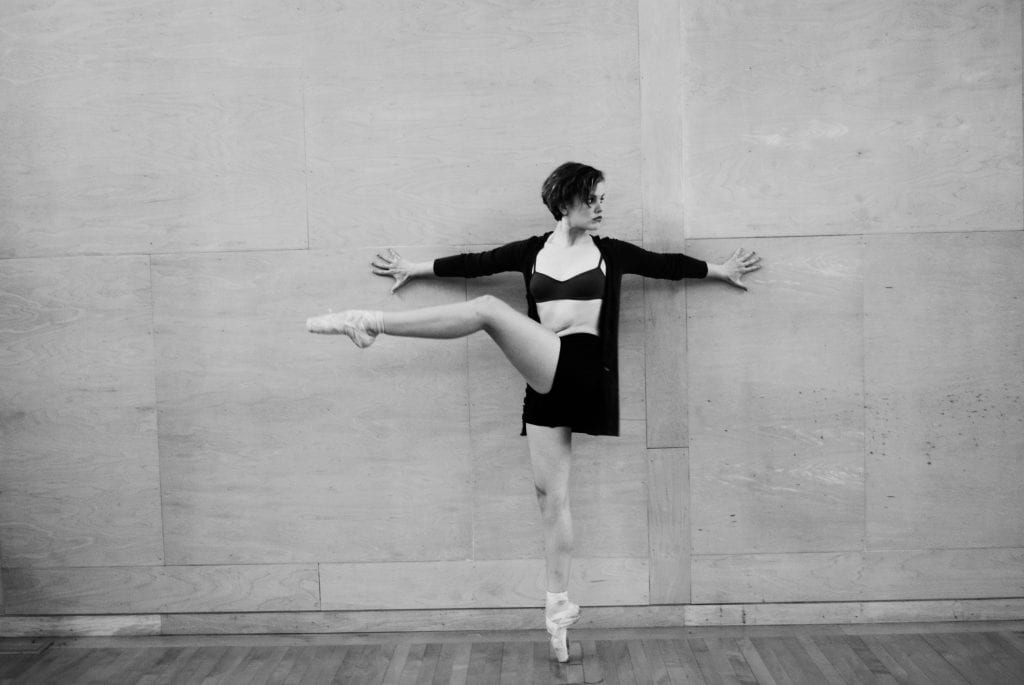
My first job abroad as a dancer was at Tokyo Disneyland. I attended an audition for the theme park in the United States. A few months later I was offered a contract to live and work in Tokyo. I left college for a year to embark upon one of the most educational experiences of my life—living and dancing in Japan.
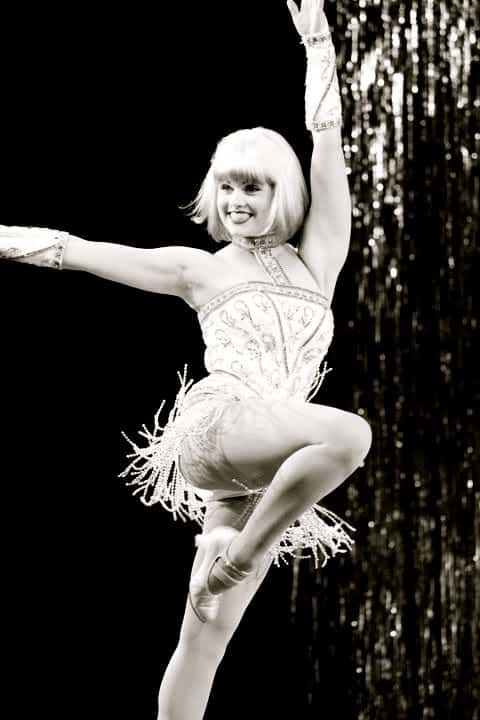
After college I took to the internet to find dance auditions for cruise ship entertainers . After countless auditions, I finally started making it through more and more rounds of dancing and singing. Soon I was measured, sized, and filling out forms with my availability. A few months later I was offered a contract to perform aboard ships for 18 months.
Besides performing aboard cruise ships I’ve also traveled as a freelance dancer, working for production companies that produce events for hotels, resorts, corporate parties, and benefits.
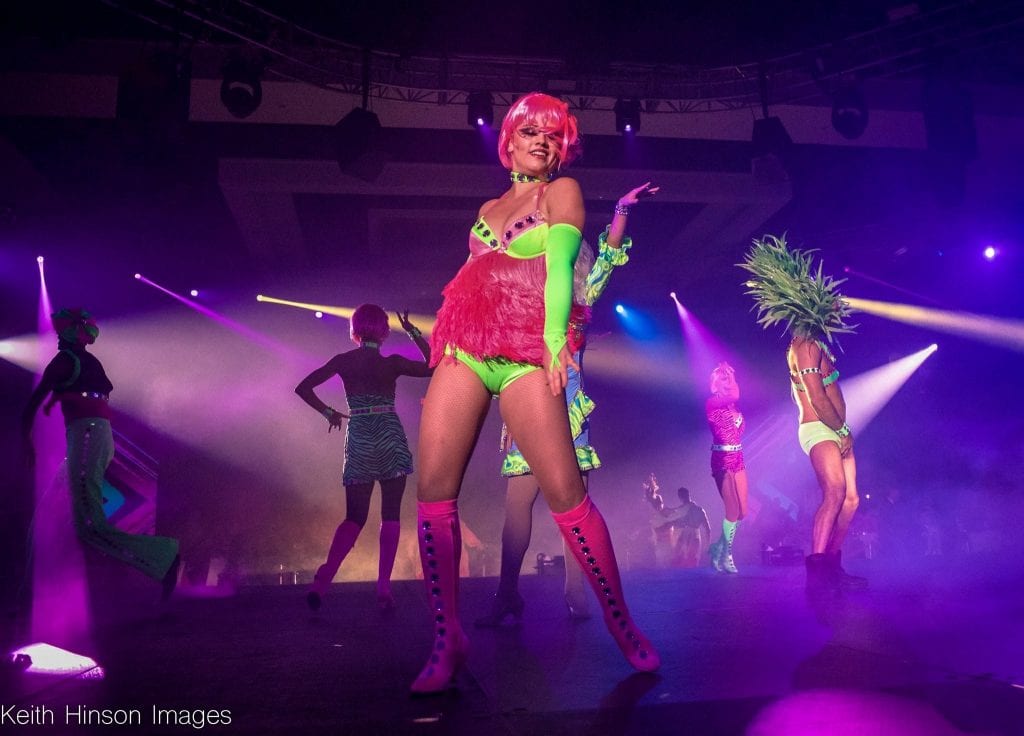
Dance has provided me with the incredible opportunity to see the world. I travel and get paid for doing a hobby I took up at age eight. And when I’m not getting paid to dance, I’m traveling on my own terms—discovering new cultures through their music and movement.
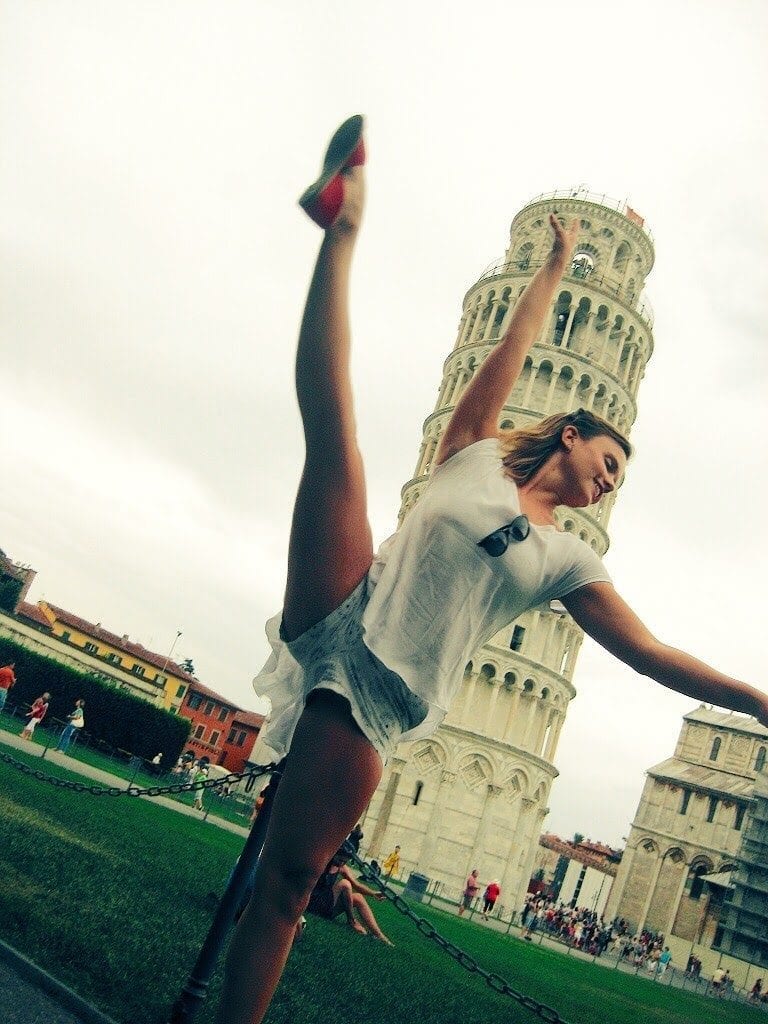
Kelsey is a dancer and performer with a mad case of wanderlust. She blogs at www.wendaway.com about dance, travel, and getting lost—in life and abroad. She’s definitely not an expert on travel, but she writes about wandering aimlessly in new countries anyway. Follow her as she figures out what a “real job” is and whether she should have one. Instagram and Twitter .
Pin this post for later:

About The Author
Guest Poster
5 thoughts on “how to travel the world as a dancer”.
one of the best way to travel! i love your dancing pics “Dance has provided me with the incredible opportunity to see the world” live with passion live with freedom as a dancing traveler !
What a great way to travel! As a dance lover and a travel lover I really enjoyed this post – if only I was good enough at dancing to fulfill my travel dreams this way!
Isn’t this fantastic! Being able to travel, earn as you go, all the while doing everything that you love!
What a great (and unique) way to travel! I have a friend who has done similar by performing with Disney on Ice (internationally and domestically) for a few years.
I love this post, it’s nice to hear someone speak (type?) so passionately about something they love! Thanks for sharing (: XX -KK #ObsessedWithEverything
Leave a Comment Cancel Reply
Your email address will not be published. Required fields are marked *
A Blythe Coach

Rollercoaster of Dance: Traveling Through Undercurve & Overcurve Pathways
- Post author By Blythe Stephens
- Post date 19. June 2021
- Categories In Allgemein
- 1 Comment on Rollercoaster of Dance: Traveling Through Undercurve & Overcurve Pathways
Like an exhilarating ride on a rollercoaster, or if you prefer, a wave, dancers ascend and descend, sink, scoop, and rise, following or leaving a pathway in space. It can be quite a thrill even at a low level of risk!
Our clarity about the described pathway in space, whether it be an scooping undercurve or arcing overcurve, affects our accuracy in performing dance steps and the impression given by our choreographic expression.
In my recent blog on Space and Focus, “ Approaches to Space: Qualities of Focus in Dance & Life ,” we distinguished between the Effort of Focus and the role Shape plays in movement, with help from a quote by Cecily Dell:
“The elements of indirectness and directness are often confused with certain aspects of movement shape, namely directional and shaping movement. While the effort qualities are concerned with the kind of concentration or focus in space , the shape aspects of movement are more related to pathways and forms the body parts create in space.” ( A Primer for Movement Description p.30, emphasis mine) In the “ Shapeshifting Dancers: Forms & How We Get There ” blog I discussed types of forms, and ways we move into and through them in ballet and dance. Here and in Episode 56 of the Podcast we’ll delve into two specific pathways that we often travel in space, so-called undercurves and overcurves .
“Undercurve” and “Overcurve” are terms mostly used in movement description (i.e. Laban Movement Analysis) and modern dance, but I also use them in teaching ballet technique because they clarify the path the steps travel through space and you will find the concepts are applicable to all movement forms.
Whether sliding, stepping, or jumping, every movement that transfers weight, travelling from one place to another, will either remain at the same level or change levels, often following an over-curving or under-curving pathway in space.
As modern dance innovators Alwin Nikolais and Murray Louis distinguish in The Nikolais/Louis Dance Technique : “Remember that in the undercurve, the transfer of weight is always in low level. In the overcurve, the transfer is always in high level.” (Location: 3,747) Let’s elaborate on the differences in action, timing, and pathway between the two types of travel.
Undercurves Described
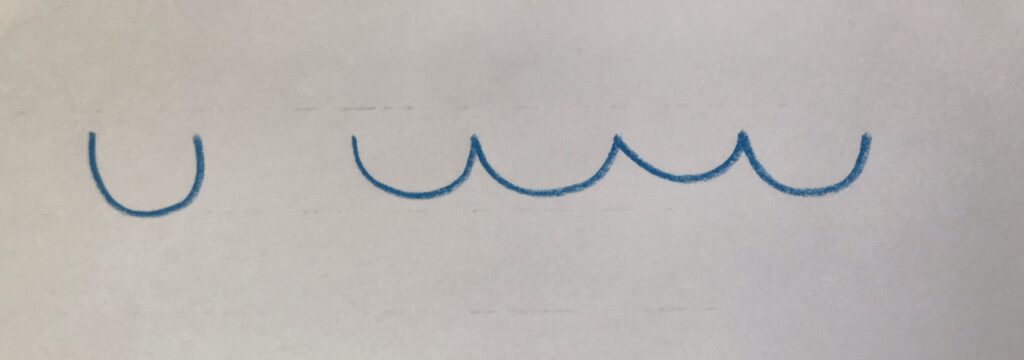
Under-curves start at a high or mid-level, sink, travel (transferring the weight on the ground), and then rise again, forming a “U”-shaped pathway in space. Performed in succession, this creates a scalloping path, like the waves of the sea in a rudimentary drawing.
According to Nikolais/Louis, “The undercurve is conceived as the lower half of a sphere. It is a continuous half circle. The locomotion of an undercurve involves a triple action of the leg: plié—transfer of weight—lift.” ( The Nikolais/Louis Dance Technique Location: 3,664) They emphasize skill in flexion and extension of the knee, “The fluidity of the flexing knee is the technical basis of both the undercurve and overcurve forms.” ( The Nikolais/Louis Dance Technique Location: 3,665)
Try out some under-curves with me with the video that follows:
Overcurves Described

Over-curves start at a low or mid-level, rise, travel (transferring weight in the air), and then sink again, forming an inverted “U” or “n”-shaped pathway in space, creating a scalloping pathway, like that of rolling hills in a rudimentary drawing.
Nikolais/Louis elaborate on movement possibilities from overcurves and undercurves: “The overcurve is the basis of the leap, just as the undercurve is the basis of the skip. Consideration is given to the upper curve of a circle. The action involves going up and stepping over.” ( The Nikolais/Louis Dance Technique Location: 3,726) They break down the overcurve step by step: “overcurve leg action is also in three parts (not three counts): Standing leg rises to high level. The other leg lifts and steps over the curve of the circle. It lowers into pliée [sic] weight is transferred.” ( The Nikolais/Louis Dance Technique Location: 3,739)
I particularly enjoy how Nikolais/Louis express the emotional requirements and impact of leaping overvurve movements: “‘Taking the air,’ being confident in the air and conscious of the space and leap action, is the motional fulfillment of the leap movement.” ( The Nikolais/Louis Dance Technique Location: 3,762)
We can certainly practice over-curve and leaping motions in a controlled, small, incremental way at first, but it is wonderful to keep in mind the ultimate potential intent of soaring through the air as we develop skills and strength.
Tim ing of Under- and Over-curves
As well as taking different pathways in space, there are rhythmic and timing differences between the two actions as well, as Nikolais/Louis explain: “ Undercurves are the basis for the quicker skip action, which has a three-eighth time value. However, the three-quarter undercurve waltz time needs to be carefully controlled so that the movement does not linger and become sentimental. […] dancer also should not confuse it with the step hop , duple time, which beginners will often substitute for the triple time undercurve skip.” ( The Nikolais/Louis Dance Technique Location: 3,673-4, emphasis mine)
Nikolais/Louis also note the inherent challenge in lingering in the air and the impact that has on the rhythm of overcurves: “It is difficult to sustain the overcurve transfer of weight. The count becomes a duple so that a phrase of undercurve. undercurve, overcurve, overcurve, overcurve would count out as 1-2-3, 1-2-3, 1-2, 1-2, 1-2.” ( The Nikolais/Louis Dance Technique Location: 3,729)

Technique notes for Under- and Over-curves
A clear change of level is necessary to describe undercurves and overcurves in space, and beginning dancers may need to exaggerate the level change to make the patterns clear. Nikolais/Louis stress the technical and physical requirements of controlling undercurve and overcurve actions:
“This triple action of the knee and leg must become automatic and smooth. The flexibility of the leg in the descent will help enormously in preparing for descending from air work.” ( The Nikolais/Louis Dance Technique Location: 3,671)
Additional reminders for performing overcurves include that the “leading front leg lifts immediately to describe the overcurve form by stepping over, lengthening, and reaching downward and out of the hip for its next …” ( The Nikolais/Louis Dance Technique Location: 3,731) and, “Lifting the straight back leg while in the air before the descent can sustain the air height longer.” ( The Nikolais/Louis Dance Technique Location: 3,763) Try these ideas when you’re ready to go for more air time!
Under- & Over-curves in Locomotion
As I elaborated on in my Do the Locomotion OR Walk Like a Dancer: walking, running, & other techniques of travel Blog, Nicolais/Louis use the concepts of undercurves and overcurves as well as approaches to time to describe the basic variations of traveling or locomotor movements in dance:
“ Walking : transferring weight evenly from leg to leg on a level path .” “ Hopping : locomotion on the same leg, transferring the weight in the air to the same leg. Transferring the weight through an undercurve or overcurve .” “ Jumping : locomotion on two legs. Transferring weight to both legs . Full turns in the air, landing and pushing off from both legs.” “ Leaping : transferring the weight from leg to leg in the air . Creating a long, horizontally level path as opposed to an overcurve . The different leaps vary in their character of traveling through the air.” “ Skipping : as opposed to a ¾ undercurve , skipping can be a duple or a ⅜ rhythm with emphasis on the push off to upward instead of low transfer of weight.” ( The Nikolais/Louis Dance Technique p.95, emphasis mine)
Examples of Under- and Over-Curves in Ballet
Under : Temps lié , Balancé , Chassé , Temps levé
Over : Pas de Bourrée, Pique, Soutenu, Soubresaut, Glissade , Pas de Chat , Grand Jeté, Saut de Chat
Chassé – Undercurves
Chassé : “to chase,” as in a cat-and-mouse game between the two feet, one getting away and then the other coming after it. We practice two types in ballet technique, both demonstrated in the video above:
Chassé À Terre : slides along the floor in a “U” or scalloped pathway (down, across, up) to an open shape, then closes again; from a closed 3rd or 5th position, sinking into Plié, transferring the weight into an open 2nd (side) or 4th position (forward or backward), then stretching the legs in the new position or sliding to assemble them in a closed position again.
Chassé with a Sauté or jump: slides along the floor to an open shape, then closes again with a spring; from a closed 3rd or 5th position, sinking into Plié, transferring the weight into an open 2nd or 4th position, then stretching the legs into a jump and assembling them in a closed position in the air, and landing on both feet again.
Pas de Chat – Overcurves
Pas de Chat has a catlike leaping effect, jumping off from one foot and landing on the other, also like a cat-and-mouse game. As with all jumps, it begins with Plié (low level) and rolls through the feet on take-off and landing. Pas de Chat travels sideways, and can be practiced in parallel before moving on to turned-out or externally-rotated position.
Leading with the leg facing the direction of travel, which is typically in back in 3rd or 5th position when turned out, the foot pushes off to Passé / lift the thigh to Retiré, then springing with the following foot to create a brief diamond shape in the air, landing on other foot in Retiré and then closing to Plié on both feet again.
Further Ballet practice videos:
- Powerful Pliés : the basic bending and stretching of the knees
- Plush Paralleleves : rising and lowering through the feet
- Centre Tendu, Temps Lié & Body Directions : sliding the feet and transferring weight from one to the other
- Ebullient Battement & Passé : Kicks the legs and lifting the knee
- Saucy Prances & Sautés : Rolling through the feet to jump
Blogs + videos on dance theory & practice:
- Planes of Space & the Body YouTube video & The Body in Space: Anatomical Dimensions, Planes, and Posture in Dance & Life blog orient us to the body and dancing space
- Ballet Orientations of the Body YouTube video & blog describe the use of space in ballet, major directions & facings
- The Seven Movements of Ballet YouTube video defines 7 essential movements
- Winsome Walking: move gracefully as a ballet dancer YouTube Video and Do the Locomotion OR Walk Like a Dancer: walking, running, & other techniques of travel Blog familiarize us with a variety of traveling steps
- Shapeshifting Dancers Blog defines basic body shapes & how they are formed
- Time Effort Blog introduces techniques for shifting our perception of time in dance and life
- Space Effort Blog introduces techniques for manipulating focus
I hope you enjoyed exploring the concepts of undercurves and overcurves in ballet and dance today, as well as practicing the steps of Chassé , Pas de Chat , and more. Let me know whether you prefer an under- or over-curving pathway while dancing or observing dance in performance!
Blythe Stephens, MFA she/her or they/them A Blythe Coach : move through life with balance, grace, & power
DISCLAIMER: A Blythe Coach recommends that you consult your physician regarding the applicability of any recommendations and follow all safety instructions before beginning any exercise program. When participating in any exercise or exercise program, there is the possibility of physical injury. If you engage in this exercise or exercise program, you agree that you do so at your own risk, are voluntarily participating in these activities, assume all risk of injury to yourself.
- Tags Artistry , Ballet , Ballet Basics , Ballet Technique , chasse , Choreography , Classical Ballet Technique , Confidence , Contemporary Dance , Expression , Jumping , Laban Movement Analysis , Leaping , Modern Dance , Movement Fundamentals , Musicality , Nikolais-Louis , Overcurves , Pas de Chat , Pathways , Rhythm , Space , Springing , Theory , Timing , Traveling Steps , Undercurves
1 thought on “ Rollercoaster of Dance: Traveling Through Undercurve & Overcurve Pathways ”
Pingback: Falling for Momentum, Swinging for the Stars | A Blythe Coach
Comments are closed.
What does the word travel mean in dance?
There are lots of ways how to travel in dance. But I'll tell you 5 of them!
2. Balance/Stilness
5.Elovution.
walking running.
basically it means to move, to "travel" from one part of the floor to another.
Add your answer:
What does travel in dance mean?
Moving to different positions.
What does the word stillness mean in the form of dance?
A dance action which is held without moving
What does pathway mean in dance?
this means how to travel from A to B by using diffrent types of pathways e.g spiral, wavy etc.
What does ballet mean in French?
It is the same as in English; they both represent the style of classical dance. 'Ballet' is originated from the word ballare in Latin, meaning 'dance'.
What does the dance word contrast mean?
A contrast in dance is similar to the meaning everywhere else. That is for the movement to be completely different form another to show the variation.
What is is the meaning of the dance word travel?
TO move across the floor.
What does the word dance mean?
the word dance means move in a slow form with music!
Does piping mean dance in Hebrew?
No. It does not. THe Hebrew word for dance is rikkud (ריקוד)
What does the word jabbawockeez mean?
It is a dance group that won ABDC.
What does the Japanese word odori mean in English?
I think it means dance
What does the German word tanzen mean?
Tanzen means to dance in English.
What does the Hebrew word Rikud mean in English?
Rikud - Dance (Noun)
What does the the Hebrew word leer-KOHD mean?
lirkod (לרקוד) = "to dance"
What does the word ' hodophobia' mean?
hodophobia - fear of travel
What is ballet mean?
the word ballet comes from the Italian 'ballare'-- to dance or to move
Top Categories


1 What Is Dance?
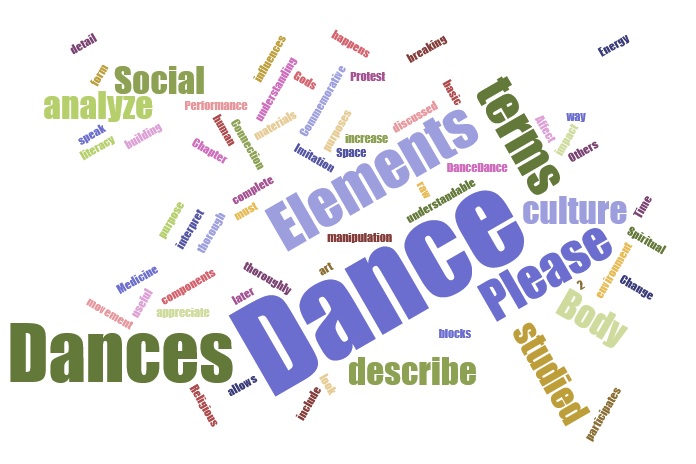
Learning Objectives
With this chapter, you will begin working toward:
- Demonstrating a culturally informed dance aesthetic.
- Identifying the purposes of dance.
Introduction
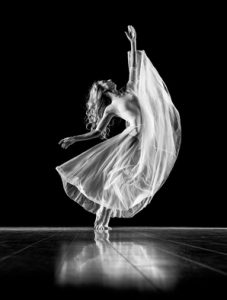
There are many definitions of dance, with people defining dance in their own way. In this chapter, you will consider your personal definition of dance. You will learn the purposes of dance. You will reflect on your experiences and upbringing to determine their influence on your dance aesthetic.
- Poetry, prose, and music are arts that exist in time. It is through the manipulation of rhythm and tempo that these arts are created.
- Painting, sculpture, and architecture are arts that exist in space. It is through the design of space that these arts are created.
- Dance is the only art that is a creation in both time and space.
How do you define dance?
Elements of Dance
Dance can be studied in terms of its raw materials. We can describe movement thoroughly by breaking dance down into its basic components. A complete understanding of the building blocks of dance allows us to analyze, interpret and speak about dance in a thorough and understandable way. To increase dance literacy and appreciate dance as an art form, we must look at the elements of dance. Through the manipulation of these elements by the human body, dance happens. The elements of dance will be discussed in more detail later in Chapter 2. To describe dance, it is useful to analyze it in terms of these Elements of Dance:
Purposes of Dance
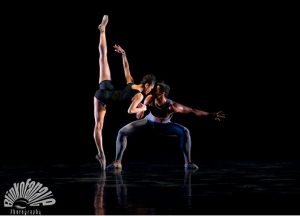
Dance can be studied in terms of its purpose and function within a culture. Cultures impact how people engage with the world, as environmental influences, societal behaviors, and attitudes are intertwined within the development and shaping of dance forms. In this respect, dance is a carrier of culture. The purposes of dance include:
- Religious Dance / Dance to Please the Gods
- Social Dance / Dance to Please Ourselves
- Performance Dance / Dance to Please Others
Religious Dance
The earliest dances were likely religious in nature. Some religions embrace dance and use it as a part of their rituals. Other religions have eschewed dance or banned it for a number of different reasons.
The ancient Greeks and Africans used to dance to solidify their community. Ancient Greek dance, as well as ancient African dance, was divinely inspired. Everyone participated in religious ceremonies as cultivated amateurs and upstanding citizens. A big part of the program was processions and circle dances. The realities of the cosmos ruled the symbolism of the dances, and references to the sun, moon, and constellations figured into the movements.
Types of Religious Dance
Dances of imitation, medicine dances, commemorative dances, dances for spiritual connection.
Particularly in primitive and indigenous cultures, dances of imitation are performed. Dancers imitate animals and natural phenomena to embody specific qualities, like channeling the prowess of an animal. The dances serve various purposes, often promoting favorable outcomes, such as good weather and hunting.
Shamans, as spiritual leaders, serve as intermediaries between the human and spirit worlds. Both men and women may be Shamans. The religion is animistic (attributes a spirit to all things), and rituals address medicine, religion, a reverence for nature, and ancestor worship. On the summer solstice, Shamans perform a fire ritual at night. The Shaman drums carry the ancestral spirits of the Shaman.
Dances are created to remember a special day, event, or meaningful moment. Some commemorative dances are very old. Maypole dances have early pagan roots. It is a celebration of the rebirth of spring. The Second Line is a West African form of dance that is a ritual to celebrate the life of the recently departed. After the slaves were brought to the New World, this dance became more of a celebration for parties and Mardi Gras festivals.
In some cultures, the dancers seek to suppress their ego to find oneness with God. In others, dance may be used to connect with dead ancestors spiritually. Some religions use dance to tell their origin stories and preserve their heritage.
Social Dance
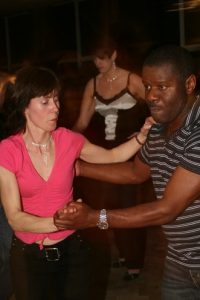
In social dance, we establish a connection with others. Social dance can be sorted into four general categories based on the purpose of the dance.
Types of Social Dance
Courtship dances, work dances, communal dances.
In cultures where marriages are arranged, men and women do not engage in courtship dances. In other cultures, dance may serve as simple flirtation or involve more complex rituals.
Some dances are centered around the work that groups perform. Dances that mimic work routines were used in past times to help build unity and continuity among the crew.

Dance has always been used in conjunction with training for war. Several cultures throughout history used dance as grounds for war preparation. The Greeks participated in pyrrhic dances and used weapons to mimic war tactics in preparation for battle. Capoeira was created by enslaved Africans in Brazil, using dance as a guise for practicing fighting. The Māori of Aotearea/New Zealand dance the Haka as an intimidation tactic that instills warriors with ferocious energy. In South Africa, the Indlamu dance was inspired by Zulu warriors during the Anglo-Zulu wars, was derived from the war dances of amabutho (warriors), and was mainly used to motivate the men before they embarked on their long marches into battles barefoot. Today, cultures continue to pass down these traditions to new generations as tradition.
Communal dances are often a part of festivals and parties. Dances like springtime’s Maypole dance and the Jewish hora bring a whole community together to share happy times. Communal dances also can be a way for a community to share grief and memories, like the Table of Silence performed at Lincoln Center every year to commemorate 9/11.
Performance Dance
Performance dances are presentational and often are entertainment for an audience. Some amateur dancers put on shows, but there are also professional dancers with highly polished techniques.
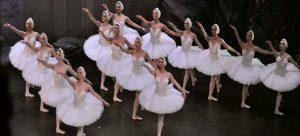
Types of Performance Dance
- Musical Theater, Film, and Television
Dance Aesthetic
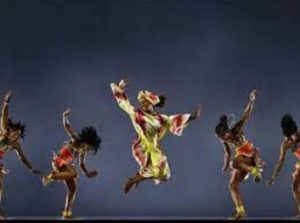
Your aesthetic is that which you find pleasing or beautiful. It includes your tastes and preferences, your “likes” and “dislikes.” Your perception of dance will be informed by your aesthetic, which might result in subjective judgments about the dances you see. Therefore, it is essential to acknowledge when these biased opinions emerge to be receptive to the dances you are witnessing and objectively respond to them. By keeping an open mind, we can better our understanding of the uniqueness of each dance as an art form.
Cultural Traditions
Culture is made up of the shared values, beliefs, and customs among a group of people and contributes to a person’s dance aesthetic. The rhythms of West Africa or Argentina that you grew up listening to can also play a part in shaping rhythmic tastes. Dance is an important way that the lore and traditions of a culture are preserved over time as they are passed down from generation to generation.
Different religions incorporate dance into their worship. Some religions include it as an intrinsic part of their ritual and even link dance to the spiritual experience. Other religions eschew dance altogether. Your religious upbringing and experiences may influence your dance aesthetic.
The program on safeguarding intangible cultural heritage in formal and non-formal education is a UNESCO initiative that recognizes that
- education plays a key role in safeguarding intangible cultural heritage.
- intangible cultural heritage can provide context-specific content and pedagogy for education programs and thus act as a leverage to increase the relevance and quality of education and improve learning outcomes.
UNESCO considers dance an intangible cultural resource. UNESCO’s Intangible Cultural Heritage division recognizes the following in its summary report on education : “The creative process of intergenerational transmission is at the center of intangible cultural heritage safeguarding.”
Family Influence
Different generations may prefer different dances. The dances your parents and their friends do are probably different from what you and your friends like. Maybe you have a grandparent who can teach you some older dances.
Do you watch dance on television, in movies, online, in live concerts and shows, at half-time? The many factors of your experiences influence your dance aesthetic.
Personal Response
You will also have a personal response to dance. Do you prefer to move fast or slow, bouncy or gliding, all over the room or just a little bit? Do you want your dance to demonstrate emotion, or do you prefer a show of virtuosity?
Kinesthetic
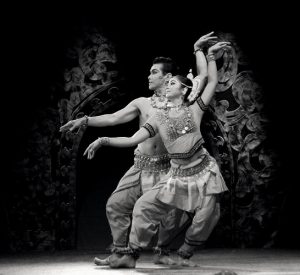
Consider your physical response to dance as you think about your dance aesthetic. Dance is capable of eliciting joy, sorrow, and a wide spectrum of emotions. What aspect of the dance spoke to your personal experiences?
Dance is a beautiful and meaningful stand-alone art. It can be performed without any ancillary arts. But it is also an art that partners successfully with other arts. Costume, scenery, poetry, drama, and music are often a part of the spectacle. As you watch dances this semester, be aware of the music, costumes, and staging that help to lend color and meaning to the dance.
In preserving a culture’s dances, one is able to preserve its stories and other art forms as well.
People have different ideas about how to define dance. One way to understand dance is to analyze its movement elements: body, energy, space, and time.
We can also study dance in terms of its purpose. Religious dances serve to imitate animals or natural elements, to achieve healing, to commemorate an occasion, or to reach spiritual connection. Social dances can serve in courtship, to find unity in work, unity in war, or camaraderie in the community. Performance dance is created and practiced for presentation to an audience. Western performance dance forms that have developed include ballet, modern dance, tap, jazz, musical theater, and hip-hop. Protest dances can be created to effect social change.
One’s dance aesthetic is shaped and influenced by numerous factors. Family, media, personal response, and kinesthetic response are all contributors to a personal aesthetic.
Check Your Understanding
- What is your definition of dance? Explain your response. How does your definition differ from those in the textbook?
- What factors influence your dance aesthetic?
Safeguarding intangible cultural heritage in education, UNESCO, https://ich.unesco.org/en/education-01017
So You Think You Know Dance? Copyright © 2022 by LOUIS: The Louisiana Library Network is licensed under a Creative Commons Attribution 4.0 International License , except where otherwise noted.
Share This Book
- International
- Schools directory
- Resources Jobs Schools directory News Search

The 5 actions of dance - jump, turn, travel, gesture and stillness
Subject: Physical education
Age range: 11-14
Resource type: Visual aid/Display
Last updated
8 December 2017
- Share through email
- Share through twitter
- Share through linkedin
- Share through facebook
- Share through pinterest

Tes paid licence How can I reuse this?
Your rating is required to reflect your happiness.
It's good to leave some feedback.
Something went wrong, please try again later.
LucindaLeigh86
Really clear and instructive resource and also very aesthetic to use as presentation material.
Empty reply does not make any sense for the end user
Report this resource to let us know if it violates our terms and conditions. Our customer service team will review your report and will be in touch.
Not quite what you were looking for? Search by keyword to find the right resource:
Glossary of Dance Terms and Common Abbreviations
Collected from many sources. Foot position diagrams are taken from Old Time Dancing by Victor Silvester, 1949.
- More from M-W
- To save this word, you'll need to log in. Log In
Definition of dance
(Entry 1 of 2)
intransitive verb
transitive verb
Definition of dance (Entry 2 of 2)
- cotillon
Examples of dance in a Sentence
These examples are programmatically compiled from various online sources to illustrate current usage of the word 'dance.' Any opinions expressed in the examples do not represent those of Merriam-Webster or its editors. Send us feedback about these examples.
Word History
Verb and Noun
Middle English dauncen , from Anglo-French dancer
14th century, in the meaning defined at intransitive sense 1
14th century, in the meaning defined at sense 1
Phrases Containing dance
- ballroom dance
- belly dance
- break dance
- contra dance
- country - dance
- dance attendance
- dance circle
- dance floor
- dance my heart out
- dance - off
- dance the night away
- dance to someone's tune
- dance to the tune of (someone)
- lead (someone) a (merry) dance
- make a song and dance about (something)
- round dance
- Saint Vitus' dance
- Saint Vitus's dance
- shadow dance
- snake dance
- song and dance
- square dance
- St. Vitus's dance
- sword dance
Articles Related to dance
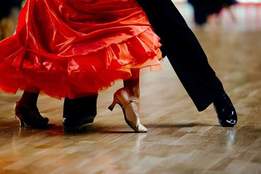
7 Phrases from the World of Dance
From the sprightly world of dance

Your Grandparents' Dirty Dancing
A history of once-banned dance crazes
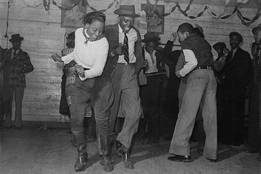
8 Ways to Face the Music
'Shimmy', 'waltz', & 6 more words from dance
Dictionary Entries Near dance
danceability
Cite this Entry
“Dance.” Merriam-Webster.com Dictionary , Merriam-Webster, https://www.merriam-webster.com/dictionary/dance. Accessed 6 May. 2024.
Kids Definition
Kids definition of dance.
Kids Definition of dance (Entry 2 of 2)
More from Merriam-Webster on dance
Nglish: Translation of dance for Spanish Speakers
Britannica English: Translation of dance for Arabic Speakers
Britannica.com: Encyclopedia article about dance
Subscribe to America's largest dictionary and get thousands more definitions and advanced search—ad free!

Can you solve 4 words at once?
Word of the day.
See Definitions and Examples »
Get Word of the Day daily email!
Popular in Grammar & Usage
More commonly misspelled words, your vs. you're: how to use them correctly, every letter is silent, sometimes: a-z list of examples, more commonly mispronounced words, how to use em dashes (—), en dashes (–) , and hyphens (-), popular in wordplay, 12 star wars words, the words of the week - may 3, a great big list of bread words, 10 scrabble words without any vowels, 8 uncommon words related to love, games & quizzes.


IMAGES
VIDEO
COMMENTS
This can involve the stationary movement of body weight from one part of the body to another or the travelling movement of a person or group from one area to another. Different types of travelling ...
A truly universal definition of dance must, therefore, return to the fundamental principle that dance is an art form or activity that utilizes the body and the range of movement of which the body is capable. Unlike the movements performed in everyday living, dance movements are not directly related to work, travel, or survival.
Anything that could lead to trouble could lead you to be deported - know the consequences. It's a great idea to keep your head on straight when you encounter troubling situations. Better yet, avoid these situations completely. 4. Make friends with the locals and performers: Of all the amazing things I've experienced traveling, the top of ...
Travel refers to the ability to move the centre of gravity along the horizontal plane with efficiency and control. As with all dance skills, a combination of elements determine the dancer's ability to travel. Alignment, strength and use of effort all play a role in a dancer's capacity to travel efficiently and safely.
15. Robam Tep Apsara - Cambodia. Apsara or Robam Tep Apsara, is a Khmer classical dance. The Khmer people are an ethnic group of Southeast Asia native to Cambodia where you are most likely to experience this form of dance, along with neighbouring nations of Thailand and Laos.
Dance can be broken down into its primary elements : body, Energy, space, and Time. It can be easily recalled through the acronym B.E.S.T. The body is the mobile instrument of the dancer and helps inform us what is moving. The body category includes shapes, actions, whole body, and part body movements.
Use the Floor. In order to travel powerfully through space, dancers need to feel connected to the floor, so they can really push off of it, says Ivalyo Alexiev, a faculty member at Boston Ballet School. During his own dance career, Alexiev found that taking barre in socks helped him understand the relationship of his feet to the floor, and he ...
Dance and Music are a universal language. Jobs in the entertainment industry exist across all borders. Cruise ship performing turned out to be how I saw much of the world, but there are a number of ways to travel as an entertainer: on tour, at theaters abroad, for a special event, or as a teacher. I didn't get a formal degree in dance, but it ...
Dance is an art form, often classified as a sport, consisting of sequences of body movements with aesthetic and often symbolic value, either improvised or purposefully selected. Dance can be categorized and described by its choreography, by its repertoire of movements or by its historical period or place of origin. Dance is typically performed with musical accompaniment, and sometimes with the ...
Dance - Movement, Expression, Art: One of the most basic motives of dance is the expression and communication of emotion. People—and even certain animals—often dance as a way of releasing powerful feelings, such as sudden accesses of high spirits, joy, impatience, or anger. These motive forces can be seen not only in the spontaneous skipping, stamping, and jumping movements often performed ...
dance, Form of expression that uses bodily movements that are rhythmic, patterned (or sometimes improvised), and usually accompanied by music.One of the oldest art forms, dance is found in every culture and is performed for purposes ranging from the ceremonial, liturgical, and magical to the theatrical, social, and simply aesthetic.
The audio version of this blog is episode 56, scroll down the blog for more resources "Undercurve" and "Overcurve" are terms mostly used in movement description (i.e. Laban Movement Analysis) and modern dance, but I also use them in teaching ballet technique because they clarify the path the steps travel through space and you will find the concepts are applicable to all movement forms.
Dancers may focus their movement and attention outwardly to the space or inwardly, into themselves. The line of travel may be quite direct towards one or more points in space or indefinite and meandering. Dancers may also orient their movement towards objects or in relation to natural settings. Sometimes dances are created for specific ...
Dance can be broken down into its primary elements: Body, Energy, Space, and Time. It can be easily recalled through the acronym B.E.S.T. The body is the mobile instrument of the dancer and helps inform us of what is moving. The body category includes shapes, actions, and whole-body and part-body movements.
There are lots of ways how to travel in dance. But I'll tell you 5 of them! 1. Turn 2. Balance/Stilness 3.Gesture 4.Jump 5.Elovution.
There are many definitions of dance, with people defining dance in their own way. In this chapter, you will consider your personal definition of dance. You will learn the purposes of dance. You will reflect on your experiences and upbringing to determine their influence on your dance aesthetic. Poetry, prose, and music are arts that exist in time.
The 5 actions of dance - jump, turn, travel, gesture and stillness. Subject: Physical education. Age range: 11-14. Resource type: Visual aid/Display. File previews. pptx, 4.27 MB. A great resource for years 7-9 dance lessons covering the 5 actions of dance. Gives examples, definitions and pictures.
A dance position in which partners face opposite directions with right hips adjacent, with right arms in front of partner at waist level, and with left arms curved up and inward, with left hands above the head (like a hat). Spin. spn. Rotate on the ball of the supporting foot.
dance: [verb] to move one's body rhythmically usually to music : to engage in or perform a dance (see 2dance 2).
ritual that include dance: (1) rites of passage, which define the passing from one age to another; (2) traditional rituals, which take place regularly. and illustrate, among others, the change of ...
Dance - Definition, Art, Expression: Self-expression and physical release may thus be seen as the two basic motives for dance. Dance itself, however, takes a wide variety of forms, from simple spontaneous activity to formalized art or from a social gathering where everyone participates to a theatrical event with dancers performing before an audience. Within this broad spectrum of forms, dance ...
To travel is the act of going from one place to another, usually a considerable distance. ... Definitions of travel. verb. change location; move, travel, or proceed, also metaphorically ... a kind of dance step in which the dancer seems to be sliding on the spot. wading. walking with your feet in shallow water.
Left Travel Thru [C3A]: Left-shoulder Pass Thru, As Couples 1/4 Left. Note: the original definition of Left Travel Thru had a Right-shoulder Pass Thru, hence some dancers may try to pass Right-shoulders and some dancers may try to pass Left-Shoulders. To be explicit as to which shoulder to pass, the caller should say Mirror Travel Thru.